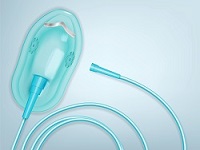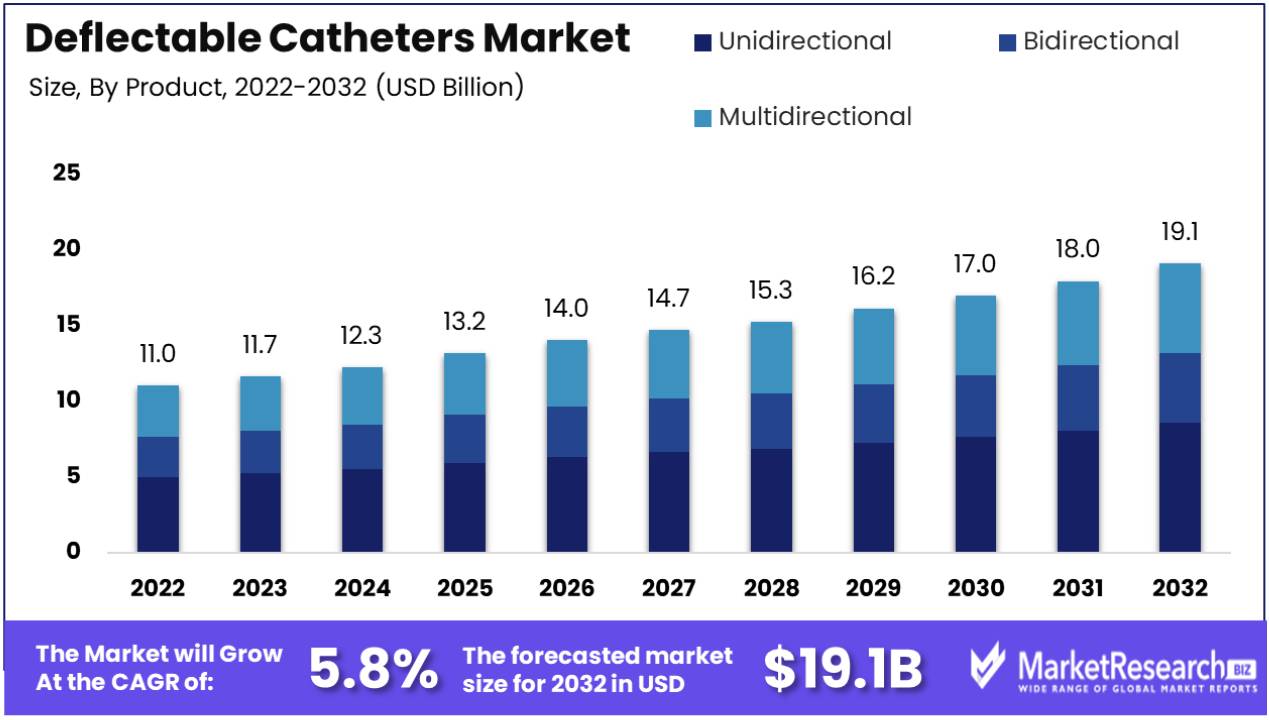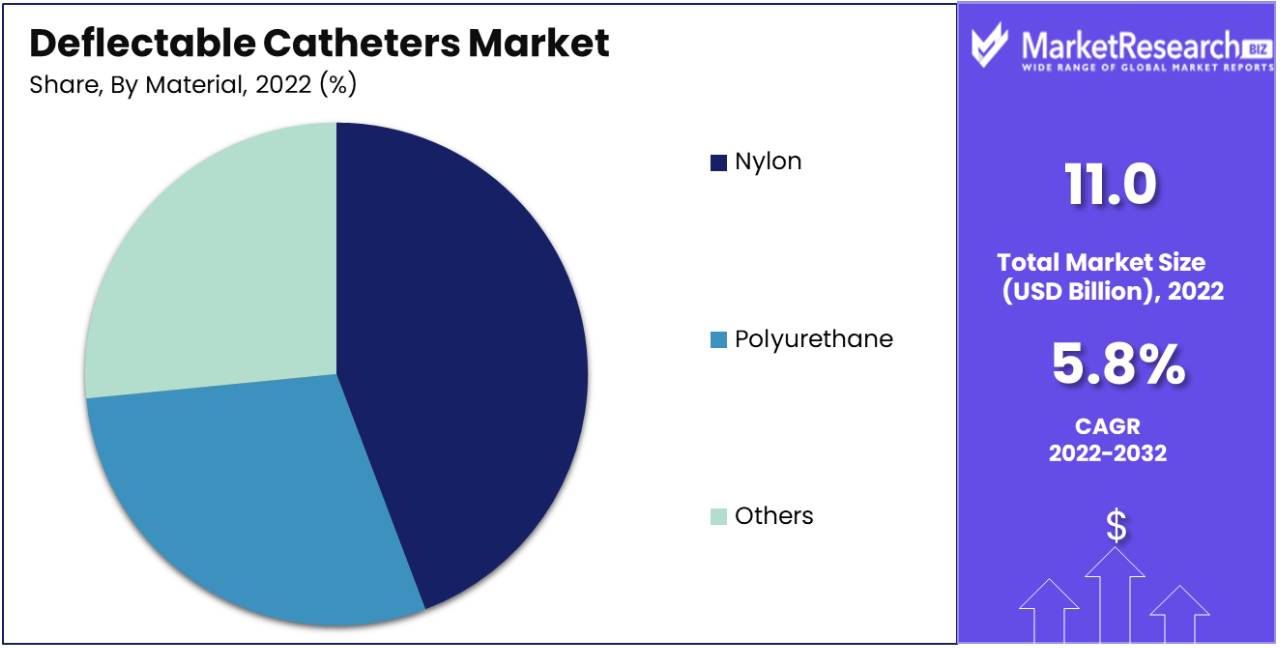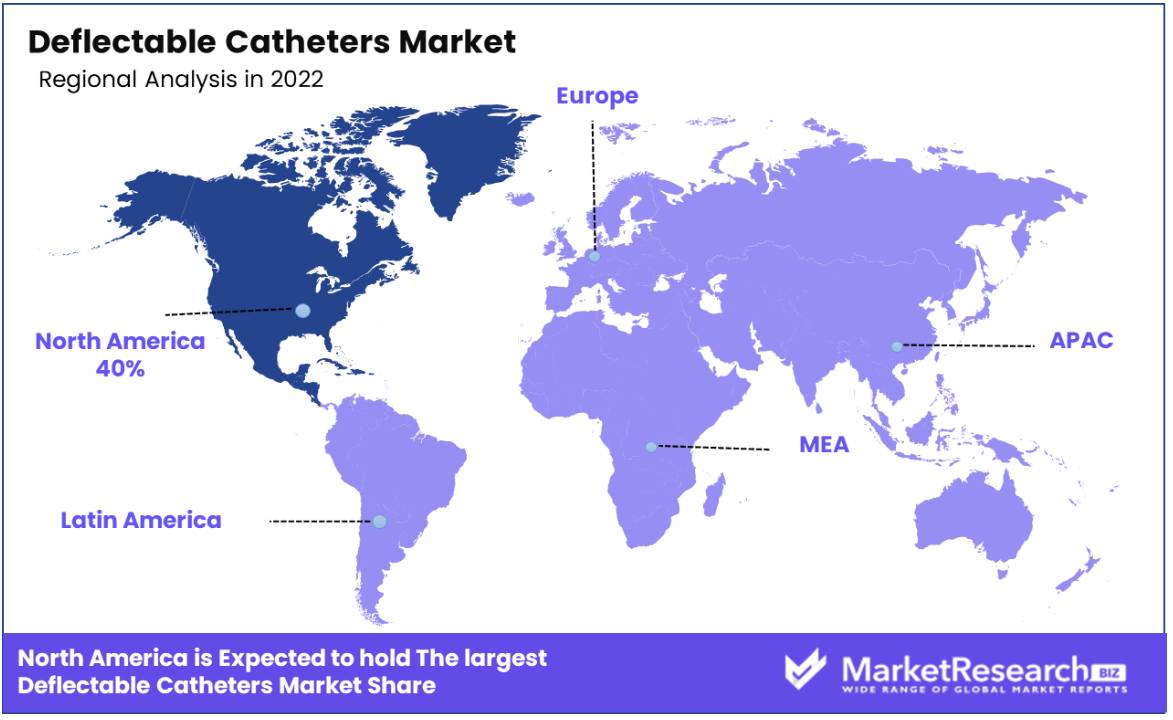
Deflectable Catheters Market By Product(Unidirectional deflectable catheters, Others), By Application(Coronary interventions, Electrophysiology, Others), By Material(Nylon, Polyurethane, Others), By End-user(Hospitals , Ambulatory surgical centers and clinics, Others), By Region And Companies - Industry Segment Outlook, Market Assessment, Competition Scenario, Trends, And Forecast 2023-2032
-
24968
-
Nov 2023
-
182
-
-
This report was compiled by Trishita Deb Trishita Deb is an experienced market research and consulting professional with over 7 years of expertise across healthcare, consumer goods, and materials, contributing to over 400 healthcare-related reports. Correspondence Team Lead- Healthcare Linkedin | Detailed Market research Methodology Our methodology involves a mix of primary research, including interviews with leading mental health experts, and secondary research from reputable medical journals and databases. View Detailed Methodology Page
-
Quick Navigation
Report Overview
Deflectable Catheters Market size is expected to be worth around USD 19.1 Bn by 2032 from USD 11.04 Bn in 2022, growing at a CAGR of 5.8% during the forecast period from 2023 to 2032.

The rise in prevalence of coronary interventions, electrophysiology, and demand in preference for minimally invasive surgeries cater to the deflectable catheter market expansion. Similarly, the increase in the number of cardiovascular surgeries is one of the major factors in this market.
As cardiovascular diseases are becoming one of the major causes of death globally, the surge in the need for better and more effective treatment methods is augmented amidst this. The use of deflectable catheters for the treatment of cardiovascular disease helps physicians to improvise maneuverability and regulate control during minimally invasive procedures.
For example, to reach the pulmonary veins in the cardiovascular the doctor has to go through the left atrium, which is mostly the source of abnormal electrical signals in atrial fibrillation. With the help of deflectable catheters, it can offer the flexibility to navigate easily through most of the difficult angles. Such flexibility will improve the effectiveness of the method and decrease the risk of several complications. Deflectable catheters can fix the adjustment in real-time will provide success of the intercession and will provide better health outcomes.
Leading manufacturers of deflectable catheters focus on gaining a competitive advantage by investing in tactical growth by using attractive profit pools. Manufacturers know the importance of deflectable catheters. Developing such devices requires attention to every minute of engineering, material science, and medical procedures.
Manufacturers need to invest continuously in R&D activities to enhance their designs and by developing It more flexible, long-lasting, and technologically advanced. Medical professionals are quite dependent upon such devices to provide quick and effective treatment for cardiovascular patients. Therefore, manufacturers in the deflectable catheters market play a significant role in advancing medical technology and improving the patient’s health by providing intensive care.
Due to new technological advancements and the launch of various types of applications, it has provided a lucrative growth opportunity in the market. Technological progressions such as the enhanced accessibility to conduct complex surgeries provide better catheter stability in operations, decreased fluoroscopy times, and reduced total radiation exposure to both medical professionals and patients. Such advantages offered by the deflectable catheters market will help expand in the forecast period.
Driving factors
Minimally Invasive Cardiovascular Surgeries Fuel Deflectable Catheters Market
The demand for minimally invasive cardiovascular surgeries is a significant driving factor for the growth of the deflectable catheters market. Minimally invasive procedures, such as angioplasty and electrophysiology studies, require the use of advanced catheters capable of precise navigation through complex vascular pathways. Deflectable catheters offer this precision, reducing the risk of complications and improving patient outcomes.
The shift from traditional open-heart surgeries to less invasive techniques has been motivated by benefits like reduced recovery times, lower risk of infections, and smaller incisions. As medical practices continue to adopt these advanced techniques, the demand for specialized tools like deflectable catheters is expected to rise, supporting ongoing market growth.
Healthcare Investment: Expanding Resources for Advanced Medical Tools
Increasing healthcare expenditure globally contributes to the expansion of the deflectable catheters market. As governments and private entities invest more in healthcare infrastructure, greater access to advanced medical technologies, including state-of-the-art catheterization tools exists. This financial support facilitates the adoption of innovative medical devices in hospitals and clinics, driving the demand for deflectable catheters.
The allocation of funds towards healthcare, particularly in developing regions, is improving patient access to high-quality medical care, including complex cardiovascular and cancer treatments that utilize deflectable catheters. This trend indicates sustained market growth factors aligned with overall healthcare investment.
Growing Geriatric Population Spurs Demand for Deflectable Catheters
The growing geriatric population worldwide spurs the demand for deflectable catheters. Older adults are more prone to cardiovascular diseases, necessitating the need for advanced diagnostic and therapeutic tools. Deflectable catheters are essential in procedures such as cardiac ablation and angiography equipment, which are commonly performed on elderly patients.
As the population ages, the prevalence of chronic diseases requiring catheter-based interventions increases. This demographic shift is a powerful driver for the deflectable catheter market, as healthcare providers seek effective tools to address the complex medical needs of an aging population.
Increasing Prevalence of Cancer Influences Deflectable Catheters Market
The increasing prevalence of cancer globally influences the growth of the deflectable catheters market. Many cancer treatments, such as chemoembolization and radiofrequency ablation, require the use of catheters for targeted therapy delivery. Deflectable catheters, with their ability to reach tumors in challenging locations, are crucial in these procedures.
As cancer incidence rates rise, the demand for effective treatment methods follows. The role of deflectable catheters in oncology is becoming increasingly important, supporting market growth. Deflectable catheters will likely remain an integral component of cancer treatments.
Overall, the deflectable catheter market growth is driven by several factors: increased demand for minimally invasive cardiovascular surgeries, rising healthcare expenditures, an aging population, and technological advancements in catheter design - these create a synergy that amplifies market expansion and innovation, leading to better patient care and medical outcomes in the long-term.
Restraining Factors
Lack of Reimbursement Policies Restrains Deflectable Catheters Market Growth
In regions where reimbursement policies for deflectable catheters are lacking or inadequate, their adoption is significantly limited. Reimbursement is a key factor in healthcare decision-making, influencing both healthcare providers' willingness and patients' ability to afford advanced medical devices such as catheters. Without adequate reimbursement, the financial burden falls directly onto these groups, making catheters less accessible in cost-sensitive markets. This lack of supportive policies can hinder market penetration and growth, as potential users may opt for more affordable, albeit less advanced, alternatives.
Availability of Alternative Treatment Options
The availability of alternative treatment options, such as open surgeries, can limit the growth of the deflectable catheter industry. In some medical conditions, open surgeries are preferred due to their established efficacy, familiarity among surgeons, or in cases where catheter-based interventions may not be suitable.
This competition from traditional surgical methods can impact the adoption rate of deflectable catheters, especially in regions where minimally invasive techniques are less prevalent or where there is a lack of trained professionals to perform catheter-based procedures.
Complications Associated with Catheter Use
The risk of complications associated with the use of catheters, such as myocardial infections and allergic reactions, can hinder sales of deflectable catheters to a certain extent. While rare, these potential adverse events are a concern for both healthcare providers and patients.
The fear of complications can influence decision-making, leading to reluctance to opt for catheter-based interventions. This concern underscores the need for continuous improvements in catheter design, materials, and procedural techniques to minimize risks and enhance patient safety, which is essential for maintaining and growing market confidence.
Segmentation Analysis of Deflectable Catheters Market
By Product Analysis
Unidirectional deflectable catheters are among the most frequently utilized options on the market due to their simplicity, ease of handling, and cost-effective nature. Offering precise control in a single plane plane makes these catheters suitable for multiple cardiovascular and electrophysiological procedures. They are especially favored in procedures where straightforward navigation through vascular structures is required. The segment's growth is supported by advancements in catheter technology, enhancing their functionality and safety.
Bidirectional and multidirectional catheters, while less common, offer greater flexibility and control, suitable for more complex anatomical navigations. Their growth is driven by the increasing complexity of interventional procedures and the need for more precise catheter positioning.
By Application Analysis
Coronary interventions represent the largest application for deflectable catheters. These procedures, including angioplasty and stenting, require precise navigation through coronary arteries, where the maneuverability of deflectable catheters is crucial. The prevalence of coronary artery diseases and the increasing preference for minimally invasive procedures drive demand in this segment. The deflectable Catheters industry holds the largest market share, especially for treating Coronary disease and thus playing a pivotal role in healthcare.
Electrophysiology utilizes these catheters for arrhythmia management. In diagnostic imaging and peripheral interventions, their flexibility facilitates enhanced visualization and treatment of peripheral vascular diseases.
By Material Analysis
Nylon is a widely used material in the production of deflectable catheters. Its popularity stems from its excellent physical properties, including flexibility, strength, and resistance to chemicals and abrasion. Nylon catheters can withstand the mechanical stresses encountered during insertion and navigation through the vascular system, making them highly reliable for a range of medical procedures.
Their durability is particularly important in complex interventions where the catheter must maintain its structural integrity under challenging conditions. Additionally, nylon's smooth surface reduces friction, facilitating easier insertion and maneuverability within blood vessels.

Polyurethane is another key material used in deflectable catheters, known for its superior flexibility and biocompatibility. This material is often chosen for applications where greater catheter flexibility is required, as it can navigate more tortuous anatomy without kinking or damaging the vessel walls. Polyurethane also possesses excellent elastic properties, allowing the catheter to return to its original shape after bending. This material's adaptability to various modifications makes it suitable for customized catheter designs, catering to specific medical needs and procedures.
By End-User Analysis
Hospitals are the primary end-users of deflectable catheters. They are equipped with advanced catheterization labs and have the requisite expertise for complex interventional procedures. The high volume of cardiovascular and electrophysiological procedures performed in the hospital segment drives the demand in this segment. The deflectable athletes industry is experiencing an increase in demand, particularly in the hospital setting, driven by healthcare regulatory changes.
Ambulatory surgical centers and specialized clinics are increasing in importance, offering more cost-effective settings for certain procedures. Independent cath labs cater to specific diagnostic and interventional needs.
Key Market Segments
By Product
- Unidirectional deflectable catheters
- Bidirectional deflectable catheters
- Multidirectional deflectable catheters
By Application
- Coronary interventions
- Electrophysiology
- Diagnostics imaging
- Peripheral interventions
By Material
- Nylon
- Polyurethane
- Others
By End-user
- Hospitals
- Ambulatory surgical centers and clinics
- Independent catheterization labs
- Other types of medical facilities
Growth Opportunity
Increasing Number of Catheterization Labs and Hospitals to Propel Growth in the Deflectable Catheters Market
The increasing number of catheterization labs and hospitals is poised to be a significant driver of growth in the deflectable catheters market. As healthcare infrastructure expands globally, the demand for interventional procedures using deflectable catheters rises.
These devices are essential for a wide range of diagnostic and therapeutic applications. Companies specializing in deflectable catheters that can meet the growing demand from healthcare facilities are well-positioned for expansion. This trend aligns with the broader need for minimally invasive procedures and drives the overall growth potential of the deflectable catheters market.
Electrophysiology Procedures Drive Growth in the Deflectable Catheters Market
Electrophysiology procedures are expected to be a primary driver of growth in the deflectable catheters market. Deflectable catheters are pivotal in mapping and navigating the intricate cardiac electrical system during electrophysiology procedures. Due to an increase in cardiac arrhythmias and their need for accurate diagnosis and treatment, demand for deflectable catheters designed specifically for electrophysiology applications has skyrocketed.
Major companies offering such high-quality deflectable catheters appear set for growth - contributing significantly to the expansion potential of the deflectable catheters market. This trend corresponds with overall attention to cardiovascular health - contributing significantly to its expansion potential as a market segment.
Regional Analysis
North America Dominates with 40% Market Share in the Deflectable Catheters Market
North America holds an estimated 40% share in the global deflectable catheters market, due primarily to its advanced healthcare infrastructure and focus on innovation in medical technology. Furthermore, cardiovascular diseases prevalent across this region as well as an aging population play a large part in driving demand for advanced catheterization techniques such as deflectable catheters.
North American market dynamics are heavily impacted by the presence of leading medical device companies and an effective regulatory framework to ensure patient safety and efficacy of medical products. Additionally, the region's inclination towards minimally invasive surgical procedures supports the adoption of advanced catheterization tools.
Forecast implications indicate that North America will continue to be a key market for deflectable catheters, with ongoing technological advancements, increasing incidence of cardiac and other diseases requiring catheterization, and a growing preference for minimally invasive surgeries.

Europe:
Europe occupies an influential place in the global deflectable catheters market, driven by advanced healthcare systems, high patient care standards, and a strong emphasis on research and development. Chronic diseases continue to rise alongside an aging population necessitating more advanced medical interventions for treatment.
The European market is projected to experience steady expansion due to technological advancements, increased healthcare expenditures, and an increasing preference for minimally invasive procedures.
Asia-Pacific:
The Asia-Pacific region is emerging as a significant player in the deflectable catheters market, driven by rapidly developing healthcare infrastructure, increasing healthcare spending, and a growing population with medical needs. The region’s burgeoning medical tourism industry also contributes to the market growth.
The future of the deflectable catheters market in Asia-Pacific looks promising, with potential growth driven by increasing awareness of advanced medical procedures, rising healthcare standards, and the expansion of medical facilities equipped with modern technologies. The growing prevalence of lifestyle-related diseases in the region is also expected to boost demand for advanced catheterization tools.
Key Regions and Countries
North America
- The US
- Canada
- Rest of North America
Europe
- Germany
- France
- The UK
- Spain
- Italy
- Russia
- Netherlands
- Rest of Europe
Asia-Pacific
- China
- Japan
- South Korea
- India
- New Zealand
- Singapore
- Thailand
- Vietnam
- Rest of Asia Pacific
Latin America
- Brazil
- Mexico
- Rest of Latin America
Middle East & Africa
- South Africa
- Saudi Arabia
- UAE
- Rest of Middle East & Africa
Key Players Analysis
In the deflectable catheters market, a blend of established medical device giants and specialized manufacturers shapes the competitive landscape. Boston Scientific and Medtronic are industry leaders, known for their extensive product ranges and significant investments in R&D. Their global distribution networks and strong brand recognition position them as influential players in setting market standards and driving innovation.
Johnson & Johnson and Abbott are also major players, leveraging their broad healthcare development portfolios and technological expertise to offer advanced demand for catheter solutions. Their market influence is underpinned by a focus on patient safety and product efficacy.
Biometrics and BioCardia, though smaller in comparison, have carved out niches with their specialized focus on biocompatible materials and cardiac applications, respectively. Their strategic positioning emphasizes targeted innovations and meeting specific clinical needs.
Overall, these key players in the deflectable catheters market drive advancement through a combination of technological innovation, strategic market expansion, and a strong focus on addressing diverse and complex clinical needs, shaping the future of minimally invasive medical procedures.
Top Key Players in Deflectable Catheters Market
- Boston Scientific
- Medtronic
- Johnson & Johnson
- Abbott, Biocardia Inc
- Biometrics
- BioCardia Inc.
- CathRx
- OSYPKA
- Biotronik
- Teleflex Incorporated
- Biosense Webster Inc.
- MAC Medical Inc.
- Japan Lifeline Co., Ltd.
- Merit Medical Systems Inc.
Recent Development
- In 2022, Abbott released its new FlexNav deflectable catheter designed to treat arrhythmias through improved maneuverability and stability.
- In 2021, Medtronic received FDA approval for its Senseonics Steerable Introducer deflectable catheter engineered for greater precision and control.
- In 2020, Boston Scientific launched the DIRECTSENSE Technology-enabled deflectable catheter providing enhanced positioning and stability.
- In 2019, Johnson & Johnson acquired Auris Health, maker of the Monarch robotic endoscopy platform used to navigate the Auris Deflectable Tip Catheter.
Report Scope
Report Features Description Market Value (2022) USD 11.04 Bn Forecast Revenue (2032) USD 19.1 Bn CAGR (2023-2032) 5.8% Base Year for Estimation 2022 Historic Period 2016-2022 Forecast Period 2023-2032 Report Coverage Revenue Forecast, Market Dynamics, COVID-19 Impact, Competitive Landscape, Recent Developments Segments Covered By Product(Unidirectional deflectable catheters, Bidirectional deflectable catheters, Multidirectional deflectable catheters), By Application(Coronary interventions, Electrophysiology, Diagnostics imaging, Peripheral interventions), By Material(Nylon, Polyurethane, Others), By End-user(Hospitals , Ambulatory surgical centers and clinics, Independent catheterization labs, Other types of medical facilities) Regional Analysis North America - The US, Canada, Rest of North America, Europe - Germany, France, The UK, Spain, Italy, Russia, Netherlands, Rest of Europe, Asia-Pacific - China, Japan, South Korea, India, New Zealand, Singapore, Thailand, Vietnam, Rest of Asia Pacific, Latin America - Brazil, Mexico, Rest of Latin America, Middle East & Africa - South Africa, Saudi Arabia, UAE, Rest of Middle East & Africa Competitive Landscape Boston Scientific, Medtronic, Johnson & Johnson, Abbott Biocardia Inc., Biomerics, BioCardia Inc., CathRx, OSYPKA, Biotronik, Teleflex Incorporated, Biosense Webster Inc., Merit Medical Systems Inc. Customization Scope Customization for segments, region/country-level will be provided. Moreover, additional customization can be done based on the requirements. Purchase Options We have three licenses to opt for: Single User License, Multi-User License (Up to 5 Users), Corporate Use License (Unlimited User and Printable PDF) -
-
- Boston Scientific
- Medtronic
- Johnson & Johnson
- Abbott, Biocardia Inc
- Biomerics
- BioCardia Inc.
- CathRx
- OSYPKA
- Biotronik
- Teleflex Incorporated
- Biosense Webster Inc.
- MAC Medical Inc.
- Japan Lifeline Co., Ltd.
- Merit Medical Systems Inc.




